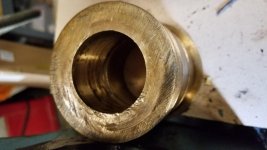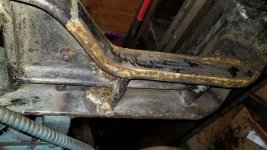I am new to owning a metal lathe picking up a Hendey Lathe this weekend for $400. It was parked in a barn and hadn't been touched for a while. SN is 23043. It is a 12x6, with a three speed Lima Motor gearbox mounted on it, the motor is 1hp, 440/220V three phase. Having no three phase in my house, I was looking at a VFD from Automation Direct with single phase input and three phase output. It came with a Whiton 4 jaw chuck mounted, no tooling or tool post included. All of the gearing appears to be in good shape from what I have seen so far. I have been reading a lot of the posts on here about these lathes and the lovely Hendyitis which this lathe currently suffers. Evidence points to someone trying to work on the spindle as the collars I and L and gear J were off already and collar E is loose, based on the drawings Johnoder has posted. I was able to remove the chuck, but haven't been able to budge the faceplate currently mounted on the spindle. I am assuming that until the faceplate is off and I remove collar A that I won't be able to remove the spindle. Any sources for appropriate pin spanners? It appears there are no pin holes left on the collars (A and 5) around the front bearing. It also appears that the rear bearing set is babbit and the front bearing set is bronze. I would show pictures but I will wait on those for a bit as I have already maxed this posts attachment limit. Any words of wisdom would be helpful with pulling the faceplate and spindle, and of course with anything else. Thanks in advance!





























